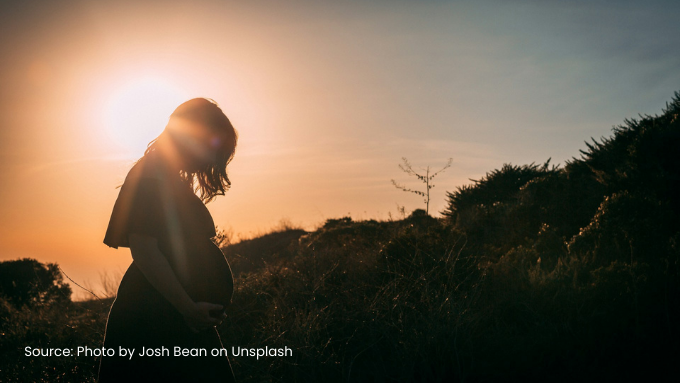Qualitative Study of Consumption Patterns in Chronic Energy Deficiency Pregnant Women in Batuputih Laok Village

Downloads
Background: hronic Energy Deficiency (CED) is a nutritional problem that often occurs in pregnant women due to chronic energy deficiency over a long period of time. Chronic Energy Deficiency (CED) in developing countries is the cumulative result of a state of malnutrition since the fetal period, infancy, and childhood that can continue into adulthood. Pregnant women with CED are at risk of giving birth to babies with low birth weight (LBW).
Objective: This study aims to analyze the causes of Chronic Energy Deficiency (CHD) in pregnant women in Batuputih Laok Village.
Method: This research method is qualitative with a descriptive research design through a phenomenological approach. The research subjects ware taken purposively. The research subjects ware pregnant woman with anemia in Batuputih Laok Village as key informants with a total of 6 people.
Results: Informants have an age range of 20-29 years with elementary, high school, and D3 education. All informants had anemia and LILA <23.5 cm so they were classified as SEVERE. In addition, the results of the in-depth interview showed that pregnant women did not want to consume foods with balanced nutrition during their pregnancy. In addition, pregnant women did not consume fish and other proteins because they did not like the fishy smell and there were restrictions on fish consumption. Some informants sometimes only eat one meal a day even though they are pregnant. Informants did not take Fe because they did not like taking medicine, and there were informants who did not take Fe during their five-month pregnancy due to nausea.
Conclusion: CED in pregnant women is caused by consumption patterns that do not want to consume high-protein foods, the existence of taboos from parents, food menus that are not diverse, food portions that are less than calorie needs, lack of meal frequency, and not taking Fe. Therefore, there is a need for counseling and nutritional counseling for pregnant women to increase knowledge about the importance of balanced nutrition for pregnant women and to correct misconceptions about food abstinence.
Abadi, E. and Putri, L.A.R. (2020) ‘Konsumsi Makronutrien pada Ibu Hamil Kekurangan Energi Kronik (KEK) di Masa Pandemi Covid-19', Jurnal Kesehatan Manarang, 6(2), p. 85. Available at: https://doi.org/10.33490/jkm.v6i2.337.
Achadi, EL, 2007, ,, Gizi dan Kesehatan Masyarakat, dalam Departemen Gizi dan Kesehatan Masyarakat``, PT. Raja Grafindo Persada: Jakarta
Arini, L.D.D. and Firdaus, E.N. (2019) ‘Pengaruh Asupan Dha Dan Protein Pada Ibu Hamil Terhadap Berat Badan Dan Panjang Janin', Prosiding Call For Paper SMIKNAS, pp. 70–77.
Andriani, Z 2015, ,, Gambaran status gizi ibu hamil berdasarkan ukuran Lingkar Lengan Atas (LILA) di Kelurahan Sukamaju Kota Depok``, Skripsi Fakultas Ilmu Kedokteran dan Kesehatan, Program Studi Ilmu Keperawatan, UIN Hidayatullah Jakarta.
Deuis Nurul Hasanah, Febrianti, M. (2013) ‘Kebiasaan Makan Menjadi Salah Satu Penyebab Kekurangan Energi Kronis (Kek) Pada Ibu Hamil Di Poli Kebidanan Rsi&a Lestari Cirendeu Tangerang Selatan', Jurnal Kesehatan Reproduksi, 4, pp. 91–104. Available at: ejournal.litbang.depkes.go.id/index.php/kespro/article/download/3907/3751.
Depkes RI 2012, ,,Kekurangan Energi Kronik pada Ibu Hamil.
Desti, RW, Ari, IS, & Puspa, S 2015, ,,Luaran Maternal dan Neonatal pada ibu bersalin dengan riwayat Kekurangan Energi Kronik di wilayah Kecamatan Jatinangor``, Jurnal Kesehatan.
Dinas Kesehatan Kabupaten sumenep (2019) ‘Profil Kesehatan Kabupaten Sumenep Tahun 2019', Dinas kesehatan Kabupaten Sumenep [Preprint].
Dinkes Jawa Timur (2020) ‘Profil Kesehatan Provinsi Jawa Timur 2019', Dinas Kesehatan Provinsi Jawa Timur, pp. 1–73. Available at: www.dinkesjatengprov.go.id.
Hidayati, F. (2011) Hubungan Antara Pola Konsumsi, Penyakit Infeksi Dan Pantang Makanan Terhadap Risiko Kurang Energi Kronis (Kek) Pad Ibu Hamil Di Puskesmas Ciputat Kota Tangerang Selatan Tahun 2011, UIN Syarif Hidayatullah.
Indonesia, M.K.R. (2014) ‘Peraturan Menteri Kesehatan Repuplik Indonesia Nomor 41 Tahun 2014', in, pp. 2071–2079.
Mahirawati, V.K. (2014) ‘Faktor-Faktor Yang Berhubungan Dengan Kekurangan Energi Kronis (Kek) Pada Ibu Hamil Di Kecamatan Kamoning Dan Tambelangan, Kabupaten Sampang, Jawa Timur', Buletin Penelitian Sistem Kesehatan, 17(2), pp. 193–202. Available at: https://media.neliti.com/media/publications/20898-ID-related-factors-of-chronic-energy-deficiency-at-pregnant-woman-in-kamoning-and-t.pdf.
Mahirawati, V.K. (2017) ‘Faktor-faktor yang Berhubungan dengan Kepatuhan Mengkonsumi Tambahan Makanan pada Ibu Hamil di Kecamatan Kamoning dan Tambelangan Kabupaten Sampang Jawa Timur', Buletin Penelitian Sistem Kesehatan, 17(2 Apr), pp. 193–202.
Mijayanti, R. et al. (2020) ‘Faktor-Faktor yang Berhubungan Dengan Kurang Energi Kronik (KEK) pada Ibu Hamil di UPT Puskesmas Rawat Inap Sukoharjo Kabupaten Pringsewu Tahun 2020', Jurnal Maternitas Aisyah, 1(3), pp. 205–219. Available at: http://journal.aisyahuniversity.ac.id/index.php/Jaman.
Qamariyah, B. and Nindya, T.S. (2018) ‘Hubungan Antara Asupan Energi, Zat Gizi Makro dan Total Energy Expenditure dengan Status Gizi Anak Sekolah Dasar', Amerta Nutrition, 2(1), p. 59. Available at: https://doi.org/10.20473/amnt.v2i1.2018.59-65.
Sumarni, S. (2017) ‘Model Sosio Ekologi Perilaku Kesehatan dan Pendekatan Continuum of Care untuk Menurunkan Angka Kematian Ibu', The Indonesian Journal of Public Health, 12, No.1(August), pp. 129–141. Available at: https://doi.org/10.20473/ijph.v12i1.2017.129.
Copyright (c) 2024 Rochmanita Ilvanadewi Fadzilah, Ita Yuliatik, Septa Indra Puspikawati, Hodimatum Mahiroh

This work is licensed under a Creative Commons Attribution-ShareAlike 4.0 International License.
Media Gizi Kesmas by Unair is licensed under a Creative Commons Attribution-ShareAlike 4.0 International License.
1. The journal allows the author(s) to hold the copyright and to retain the publishing right of the article without restrictions.
2. The legal formal aspect of journal publication accessibility refers to Creative Commons Attribution-Share-Alike (CC BY-SA).
3. The Creative Commons Attribution-Share-Alike (CC BY-SA) license allows re-distribution and re-use of a licensed work on the conditions that the creator is appropriately credited and that any derivative work is made available under "the same, similar or a compatible license”. Other than the conditions mentioned above, the editorial board is not responsible for copyright violations.



















